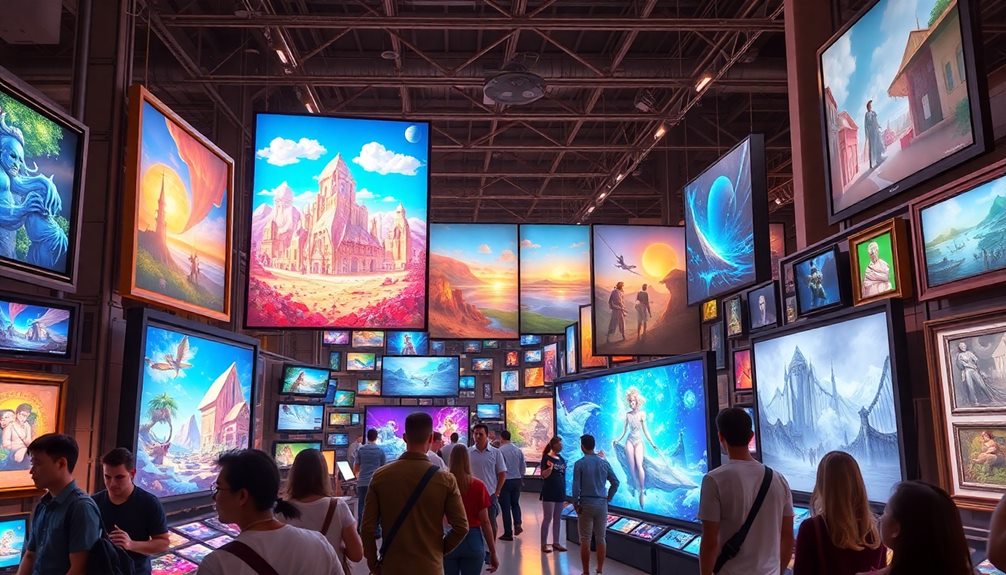NFT art and traditional digital art sales are merging, reshaping the way you connect with art. The blockchain guarantees authenticity in NFTs, while traditional digital art gains recognition in galleries. Auction houses like Sotheby's and Christie's are embracing both worlds, projecting significant growth in sales. With celebrities endorsing NFTs, interest skyrockets among younger collectors. As more artists explore these mediums, opportunities for collaboration and innovation increase. This evolving landscape indicates a vibrant future for digital art, and there's much more to discover about these exciting trends and how they might impact your journey in art collecting or creation.
Key Takeaways
- NFT art leverages blockchain for digital ownership, providing artists a direct connection with collectors and enhancing market opportunities.
- Traditional digital art is gaining recognition and appreciation, with evolving trends and technologies expanding its audience and market potential.
- Auction houses are integrating digital art sales, significantly increasing market visibility and legitimacy for both NFTs and traditional digital artworks.
- Celebrity involvement in NFTs has heightened interest and sales, bridging gaps between generations in understanding digital art.
- Projections indicate a tenfold increase in digital art sales in five years, driven by younger collectors and innovations in technology like generative art.
Overview of NFT Art

As the digital landscape evolves, NFT art has emerged as a revolutionary way for artists to showcase their work and connect with collectors. Unlike the traditional art world, where ownership can be ambiguous, NFTs provide digital ownership through blockchain technology. This unique feature assigns a digital certificate of authenticity to each piece, allowing artists to establish their work's ownership and scarcity, which can greatly enhance its market value.
By maintaining a positive energy around their creations, artists can attract more opportunities and establish a strong presence in this new market, aligning with Abraham's Business Success Principles for professional growth.
High-profile sales, such as Beeple's "Everydays: The First 5,000 Days" selling for $69.3 million at Christie's, highlight the potential for considerable sales in the NFT market. While the market experienced a dramatic downturn in 2022, with transactions plummeting by 97%, it has since stabilized, fostering ongoing exhibitions and sales in 2023.
This resurgence not only revitalizes interest but also solidifies the NFT ecosystem as a legitimate platform for artists and collectors alike. Major auction houses, including Sotheby's and Christie's, have embraced NFT art, further legitimizing it within the art community.
As this landscape continues to evolve, both artists and collectors can navigate new opportunities for creativity and investment.
Traditional Digital Art Landscape

As you explore the traditional digital art landscape, you'll notice how evolving trends are reshaping what we consider art.
The integration of cutting-edge technologies, like AI and interactive platforms, is pushing boundaries and attracting new audiences.
This transformation is similar to advancements seen in automation across various industries, which not only enhances the creative process but also redefines the way art is experienced and collected.
Evolving Digital Art Trends
Digital art is rapidly evolving, showcasing a vibrant landscape that includes digital painting, AI creations, and generative art. As you explore this dynamic field, it's clear that the digital art market is expanding, driven by innovations in digital techniques and tools.
The rise of diversity through global creators is also influencing the digital art scene, encouraging a broader range of perspectives and cultural expressions. Here are some notable trends:
- Increased Recognition: Early pioneers like Vera Molnar are gaining renewed appreciation, highlighting the historical significance of digital art practices.
- Mainstream Integration: Major international art events, such as Art Basel and Venice Biennale, now frequently feature significant digital art exhibitions, demonstrating growing acceptance.
- Collectors' Interest: As of early 2023, digital art accounted for only 3% of high-net-worth collectors' expenditures, indicating substantial room for growth in this segment.
- Diverse Ecosystem: The integration of digital art into traditional institutions fosters a healthy ecosystem, encouraging artists working across various mediums.
These trends suggest a promising future for digital art, as traditional collectors become increasingly engaged and open to new forms of expression.
Embrace this evolving landscape, and you'll find plenty of opportunities to discover and invest in the future of digital art.
Integration of Technologies
The integration of technologies within the traditional digital art landscape is transforming how creators and collectors interact with art. Digital art now encompasses diverse forms, including AI art and generative works, and it's gaining traction at major events like Art Basel and the Venice Biennale. This increasing acceptance signals a bright future for traditional art alongside its digital counterparts.
Blockchain technology plays a pivotal role in this shift, offering innovations such as NFTs that link digital pieces to physical artworks. Collectors now have access to fractional ownership models, making it easier to invest in high-value pieces.
With platforms like Artrade introducing RWA tokens, the lines between traditional and digital art continue to blur.
As you engage with this evolving landscape, you'll notice that generative art isn't only appealing for its creativity but also for the community-building potential it fosters. This integration of technologies enhances the overall experience for collectors, enabling new ways to own and appreciate art.
As the digital art market expands, it's clear that the fusion of traditional practices with cutting-edge technology will redefine the future of art.
Market Dynamics and Trends

Recent shifts in the art market reveal a newfound stability for digital art, moving away from the speculative frenzy that characterized the early NFT boom. As digital art sales gain traction, the dynamics are evolving, attracting diverse audiences and traditional art collectors alike.
Here are some key trends to note:
- Organic Growth: The digital art market is experiencing steady growth, focusing on genuine appreciation for artists and their work.
- Increased Interest: Early 2023 data shows that digital art represented only 3% of high-net-worth collectors' expenditures, hinting at significant future potential.
- Younger Generation: A staggering 87% of digital art collectors are under 40, signaling a shift in demographics and a fresh infusion of energy into the market.
- Auction Houses' Role: Major auction houses like Sotheby's and Christie's are integrating digital art sales, with projections indicating a tenfold increase in this sector within five years.
These market dynamics suggest a promising future for digital art, bridging the gap between traditional collectors and the younger generation enthusiastic to engage with this evolving landscape.
The Role of Auction Houses

As the digital art market matures, auction houses are stepping up to play a significant role in shaping its future. Major players like Sotheby's and Christie's have recognized the importance of digital art, with Sotheby's launching its Metaverse platform in 2021 to enhance the auction experience specifically for NFTs and digital art.
Their successful sales in 2023 indicate a growing acceptance of this market segment, which is essential for artists looking to establish themselves. Auction houses provide a trusted environment for transactions, legitimizing digital art for investors.
This trust is crucial, especially as digital art sales are projected to potentially increase tenfold within the next five years. By integrating digital art into traditional auction practices, these houses are merging contemporary and classical art forms, attracting a diverse range of collectors and investors.
For artists, this shift not only opens up new avenues for sales but also elevates the perceived value of their work. As auction houses continue to embrace NFT technology and digital art, you can expect to see more high-value sales and a wider appreciation for these innovative art forms.
Sales Trends in Digital Art

As you explore the evolving landscape of digital art sales, you'll notice how auction houses are shaping market dynamics.
Their influence is driving collector engagement trends, creating new opportunities for artists and buyers alike.
With projections of significant growth on the horizon, now's the perfect time to pay attention to this thriving sector.
Evolving Market Dynamics
The digital art market is witnessing a transformative shift, with significant trends emerging that could reshape its future. As a collector, you should pay attention to these evolving market dynamics that are influencing digital art sales today.
- Growth Potential: Digital art accounted for just 3% of high-net-worth collectors' expenditures in early 2023, highlighting a substantial opportunity for growth.
- NFT Trading Decline: The NFT market saw a staggering 97% drop in transactions from January to September 2022, signaling a shift in sales dynamics.
- Auction House Success: Major auction houses like Sotheby's and Christie's are finding success in digital art sales, indicating its acceptance within traditional art platforms.
- Younger Collectors: A staggering 87% of digital art collectors are under 40, suggesting that this demographic shift will drive future innovations and sales trends.
With digital art sales projected to increase tenfold at auction houses over the next five years, now's the time to explore the exciting possibilities in this evolving landscape.
Embracing these trends could lead to discovering unique artworks and connecting with a vibrant community of fellow collectors.
Auction House Influence
Witnessing a surge in popularity, auction houses like Sotheby's and Christie's are redefining the landscape of digital art sales.
In 2023, these major players greatly boosted their engagement with digital art, conducting multiple successful sales that enhance the legitimacy and visibility of this evolving market.
Sotheby's Metaverse, launched in 2021, has transformed the auction experience, and projections suggest that digital art sales at auction houses could increase tenfold in the next five years.
Collector Engagement Trends
Collector engagement in the digital art market is on the rise, reflecting a significant shift in how art is bought and appreciated.
With predictions of a tenfold increase in digital art sales over the next five years, it's clear that collectors are becoming more intrigued.
Here's what's driving this trend:
- Younger Collectors: 87% of digital art collectors are under 40, showing a clear generational shift.
- Auction Houses: Despite digital art accounting for only 3% of expenditures among high-net-worth collectors, this segment has substantial growth potential.
- Major Exhibitions: Events like Art Basel's Digital Art Mile and the Venice Biennale are increasingly showcasing digital art exhibitions, boosting visibility.
- Discerning Collectors: The market is stabilizing, moving away from speculative trends, allowing collectors to appreciate the work of NFT artists more deeply.
As the art market evolves, you'll find that these trends are creating new opportunities for engagement and investment in digital art.
Impact of Celebrity Involvement

With celebrities stepping into the NFT arena, the market's visibility has skyrocketed. High-profile sales, like Jack Dorsey's first tweet auctioned for about $2.5 million and Rob Gronkowski's trading cards raking in over $1.6 million, have drawn attention to the power of celebrity involvement in the art industry.
This surge in interest showcases the commercial appeal of NFTs, attracting a broader audience that may not have previously engaged with digital art.
The NBA Top Shot platform, backed by famous athletes, has generated over $390 million in sales since its launch. This impressive figure highlights how endorsements can lead to mainstream acceptance of NFTs.
Artists such as Kings of Leon have also successfully entered this space, earning over $2 million from music-related NFTs, illustrating the potential crossover between music and digital art.
Moreover, as celebrities continue to enter the NFT market, the generational divide in understanding these innovative art forms is shrinking.
Younger audiences, influenced by their favorite stars, are increasingly embracing the world of NFTs, paving the way for a new era in the art industry.
Future of Digital Art Sales

As we look ahead, digital art sales are poised for remarkable growth, with projections suggesting a tenfold increase within the next five years. This surge will be driven by several key factors reshaping the digital art landscape.
- Rise of NFTs: Non-fungible tokens are revolutionizing ownership, allowing digital artists to secure their rights and connect directly with collectors.
- Young Collectors: With 87% of digital art collectors under 40, this demographic is embracing digital art more than ever, pushing for innovation and diversity in the market.
- Generative AI Integration: As AI technology evolves, it offers new avenues for creativity, enhancing the appeal of digital art and attracting a broader audience.
- Art Event Influence: Major events like Art Basel showcase significant digital art, signaling its growing acceptance and importance in the mainstream art world.
The future of digital art sales looks bright, with smart contracts providing transparency and security, ensuring both digital artists and collectors benefit.
As you navigate this exciting landscape, stay informed and embrace the changes that lie ahead.
Frequently Asked Questions
How Much Does Average NFT Art Sell For?
The average NFT art piece sells for around $200 to $300, making it accessible for many collectors. However, prices can vary widely, with some pieces reaching staggering amounts, reflecting market volatility and unique demand.
What Type of Digital Art Sells the Most?
Think of Picasso's vibrant brushstrokes; today, dynamic generative art captures collectors' hearts. Unique, innovative pieces with community engagement often sell best, reflecting a shift towards digital expressions that resonate deeply with audiences and investors alike.
Is It Worth Selling Art as NFT?
Selling art as NFTs can be worth it for you. You'll gain direct access to a global market, retain more profits, and benefit from ongoing royalties, enhancing your financial stability and creative recognition over time.
Is Digital Art as Valuable as Traditional Art?
Think of digital art like a fresh breeze—exciting but still finding its place. While its value's rising, it often can't compete with traditional art's established prestige and market presence. You'll see this shift unfold gradually.
Conclusion
As you immerse yourself in the world of NFT art and traditional digital art sales, it's clear that the landscape is evolving at lightning speed. The fusion of technology and creativity is creating a vibrant marketplace that's unlike anything we've seen before. Whether you're an artist, collector, or simply an enthusiast, the future holds endless possibilities. So, buckle up—this ride through the digital art revolution is about to take you to exhilarating heights you never thought possible!









